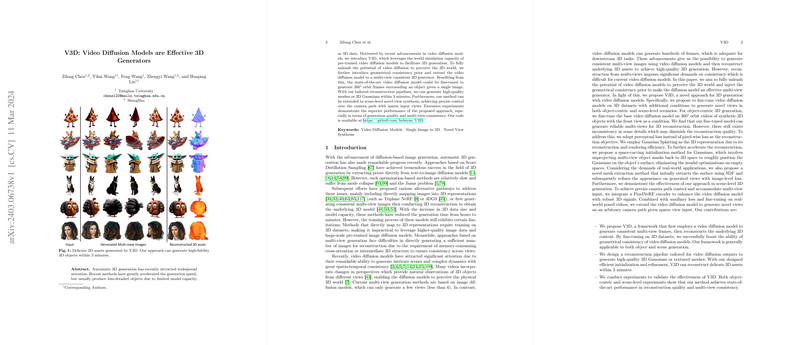Leveraging Video Diffusion Models for Efficient 3D Generation: Introducing V3D
Overview
The recent advancements in automatic 3D generation have seen a surge in leveraging pre-trained models for creating detailed 3D objects. However, existing methods often grapple with issues such as slow generation speeds, less-detailed output, or the constraints of requiring extensive 3D data. Addressing these challenges, the paper introduces V3D, a novel framework that utilizes video diffusion models, pre-trained on large datasets, to enhance the process of 3D generation. This approach not only accelerates the generation speed but also significantly improves detail and fidelity in the generated 3D objects.
Core Contributions
The paper makes several notable contributions to the field of 3D generation. Firstly, it proposes a method to repurpose video diffusion models for generating dense multi-view frames from a single input image, which are then used to reconstruct high-quality 3D models. This approach leverages the inherent capability of video diffusion models to perceive and simulate the 3D world, thus facilitating the generation of detailed and consistent views of objects and scenes.
Secondly, the authors introduce a tailored reconstruction pipeline that generates high-quality meshes or 3D Gaussians within a timeframe of 3 minutes. This is a remarkable achievement considering the quality and efficiency it brings to the table compared to existing methods. For object-centric generation, the paper demonstrates fine-tuning strategies on synthetic data to achieve compelling results in generating views around objects, providing a fertile ground for high-quality 3D reconstruction.
Furthermore, the method is extended to scene-level generation, demonstrating its versatility and ability to handle complex scenes with dynamically controlled camera paths. This expansion showcases the potential of video diffusion models in broader applications beyond object-centric tasks.
Experimental Results
The paper presents extensive experimental results to validate the effectiveness of the V3D approach. It outperforms state-of-the-art methods in terms of generation quality and multi-view consistency, as demonstrated in both object-centric and scene-level experiments. Through qualitative comparisons and user studies, V3D is shown to significantly improve alignment with input images and fidelity of the generated 3D objects. Additionally, in scene-level novel view synthesis, V3D showcases remarkable performance, suggesting its strong potential for real-world applications.
Future Directions
The findings of this research pave the way for numerous future developments. The capability to efficiently generate detailed 3D objects and scenes from minimal input heralds a new era for applications in virtual reality, game development, and film production. Furthermore, the successful application of pre-trained video diffusion models in 3D generation opens avenues for exploring other pre-trained models in similar tasks, potentially leading to even more powerful and efficient 3D generation methods.
Moreover, addressing the framework's limitations, such as occasional inconsistencies or the generation of unreasonable geometries, could further refine the approach. Continuous improvements and adaptations can enhance its applicability and performance across a broader range of inputs and scenarios.
Concluding Remarks
In summary, the V3D framework marks a significant step forward in leveraging video diffusion models for efficient and high-fidelity 3D generation. Its success in generating detailed objects and scenes within minutes, as opposed to hours required by previous methods, sets a new benchmark for the field. As technology progresses, the integration of such advanced methodologies will undoubtedly revolutionize the ways we interact with digital content, creating more immersive and detailed virtual environments.
